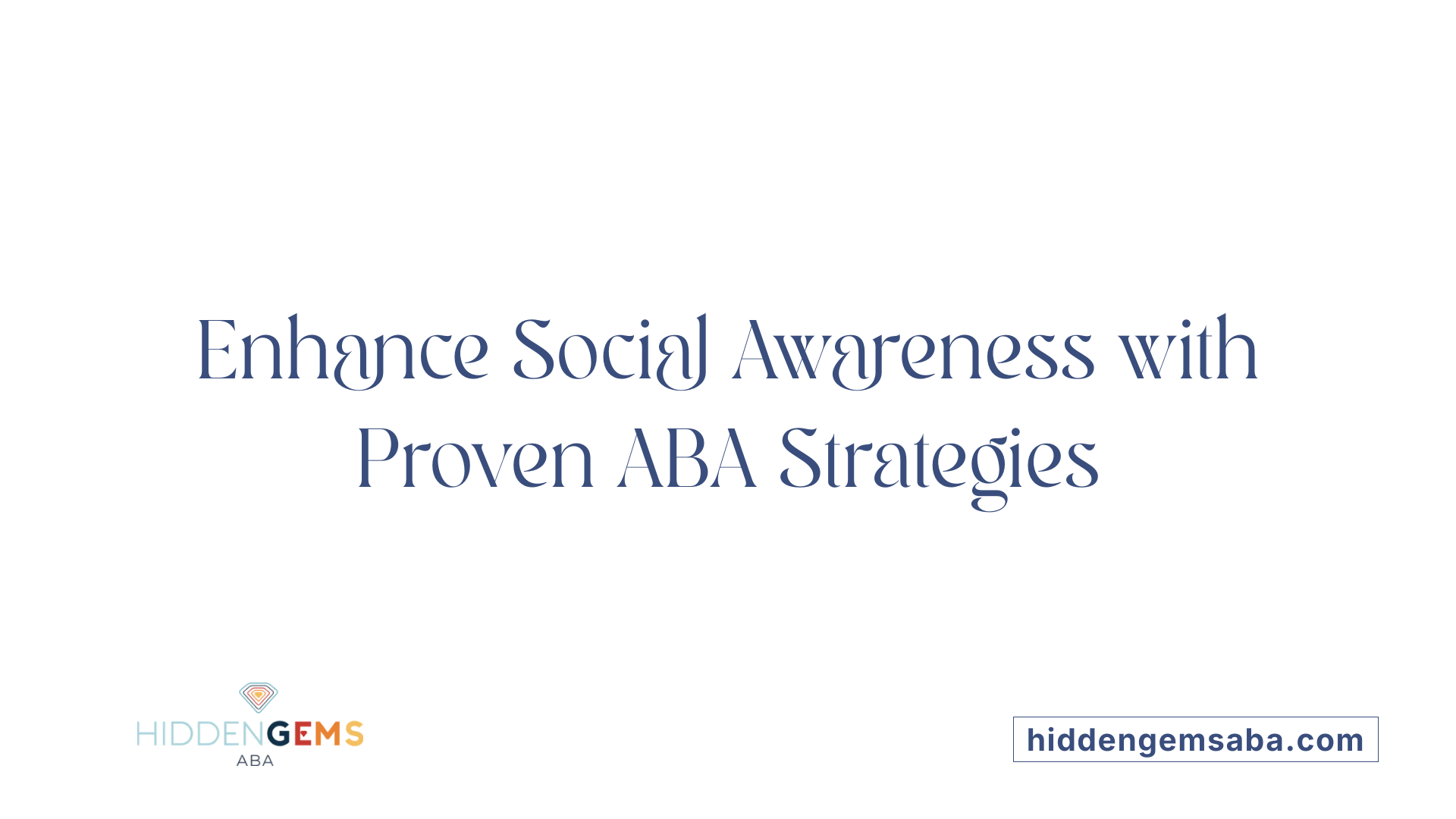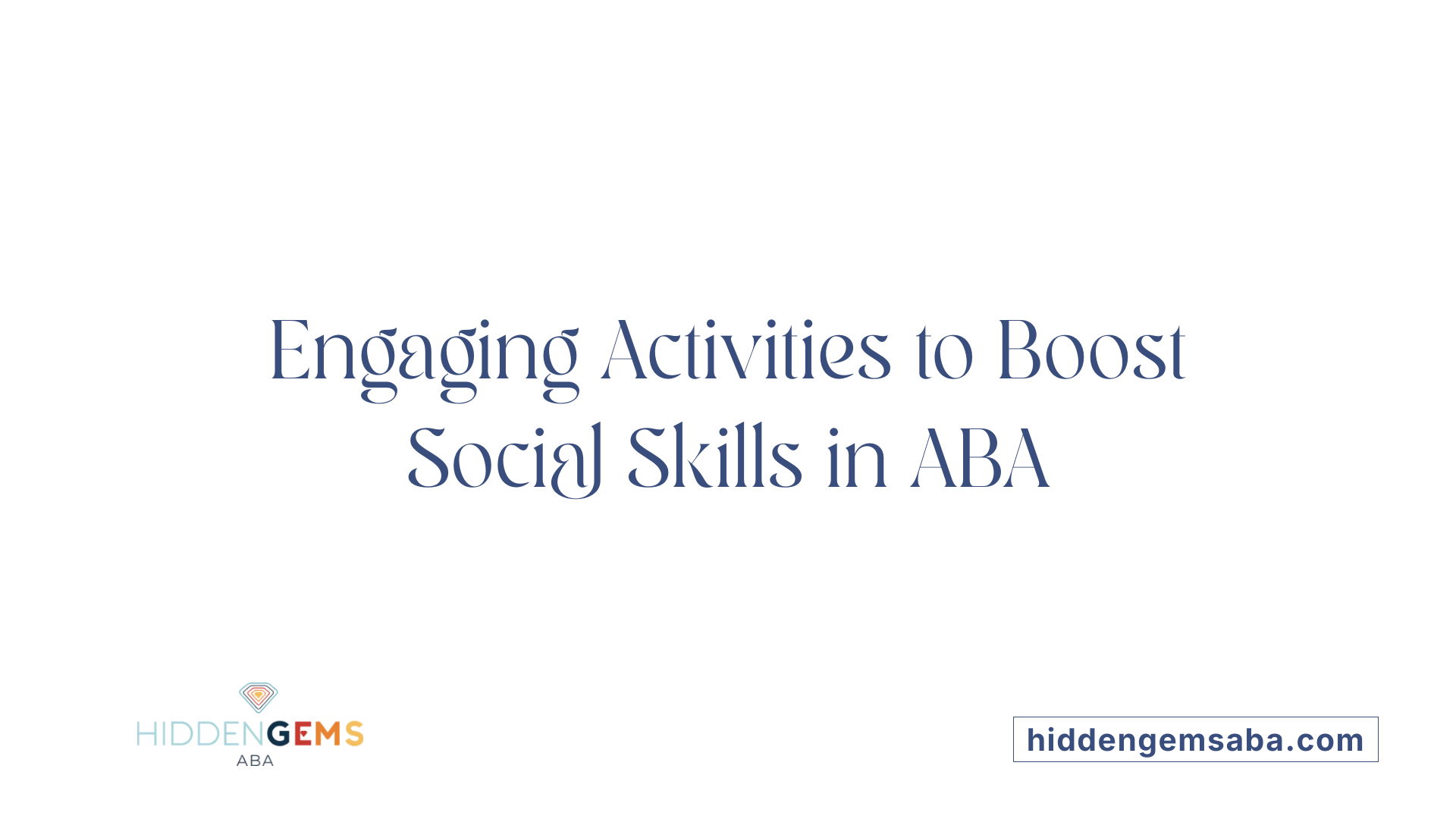Understanding the Role of ABA in Social Development for Children with Autism
Applied Behavior Analysis (ABA) is a scientifically supported therapy that has transformed the way children with autism develop essential social skills. Rooted in the science of learning and behavior, ABA enables tailored strategies to foster meaningful social interactions, emotional growth, and adaptive behaviors, enhancing quality of life for children and their families.
What is ABA Therapy and Its Principles
What is ABA therapy and how does it aim to improve social behaviors in children with autism?
Applied Behavior Analysis (ABA) is a therapy rooted in the science of learning and behavior. Its primary goal is to help children with autism develop better social skills, communication, and independence. ABA works by examining how a child's environment influences their behavior and then applying specific strategies to promote positive actions.
Central to ABA is the use of positive reinforcement. When a child displays a desired behavior, they are rewarded—this could be through praise, toys, or other incentives—encouraging them to repeat these helpful behaviors. ABA also employs techniques like prompting and communication training to support skill development.
Each ABA program is customized to suit individual needs. Qualified professionals, often Board Certified Behavior Analysts (BCBAs), conduct thorough assessments to identify specific goals for each child. Based on this evaluation, they design tailored intervention plans focusing on improving social interactions, calming anxiety, and fostering communication.
Through structured sessions that include role-playing and social stories, children practice interpreting social cues, initiating conversations, and understanding emotions. These activities help children with autism navigate social environments more effectively. Over time, ABA helps reduce problematic behaviors while strengthening positive social and emotional skills.
Supported by more than 20 scientific studies, ABA is recognized as an evidence-based, effective treatment for enhancing social skills and reducing challenging behaviors in children with autism. Its flexible approach allows therapy to be delivered in various settings, including homes, clinics, and schools, ensuring a supportive and consistent learning environment.
Effectiveness of ABA in Social and Emotional Development
How effective is ABA therapy in developing social and emotional skills in children with autism?
Research confirms that ABA (Applied Behavior Analysis) is highly effective in improving social and emotional abilities among children with autism. Numerous scientific studies and meta-analyses, including over 20 research projects, demonstrate that ABA results in significant progress in areas such as socialization, communication, and everyday functioning.
A well-known study involving 60 boys aged 4 to 11 showed that children who received individually tailored ABA programs in structured settings exhibited notable improvements in their social skills, language, and adaptive behaviors. These programs typically include activities like role-playing, social stories, and positive reinforcement, which help children recognize social cues, interpret emotions, and interact more confidently.
ABA's emphasis on measurable progress allows therapists to tailor interventions based on thorough assessments by trained behavior analysts. Consistent, long-term engagement—often 25 to 40 hours weekly over multiple years—has been linked to substantial gains in social awareness, independence, and emotional understanding.
Improvements in social skills
Children participating in ABA programs learn to interpret social signals, maintain eye contact, start conversations, and respect personal boundaries. Techniques such as peer interactions and collaborative play in group sessions further promote friendship-building and social confidence.
Role-playing and peer modeling are among the strategies that help children rehearse real-life social situations, easing their transition into natural social environments. For children with social anxiety, ABA introduces gradual exposure and relaxation techniques to foster comfort and engagement.
Long-term benefits
The benefits of ABA extend beyond immediate skill development. It supports lifelong improvements in social functioning and emotional resilience. By systematically teaching how to understand and respond to social cues, children grow more adept at navigating community settings and forming meaningful relationships.
With continued therapy, many children experience enhanced parenting interactions, better self-care skills, and increased life satisfaction. The American Psychological Association and the US Surgeon General recognize ABA as an evidence-based, best-practice approach supported by conclusive research.
| Aspect | Description | Supporting Evidence |
|---|---|---|
| Social Skills Development | Interpreting cues, conversation, empathy | Multiple studies, meta-analyses (85-95% success rate) |
| Emotional Skills | Recognizing and managing emotions | Long-term studies, structured interventions |
| Overall Outcomes | Peer interactions, independence | Randomized controlled trials, clinical observations |
Strategies and Techniques to Promote Social Awareness

What strategies and techniques are used in ABA therapy to enhance social awareness and interaction?
ABA therapy employs a variety of approaches to improve social skills and awareness among children with autism spectrum disorder (ASD). These strategies are designed to help children interpret social cues, communicate effectively, and build meaningful peer relationships.
Reinforcement methods are central to ABA, where positive behaviors such as maintaining eye contact, sharing, and taking turns are rewarded with praise or other incentives. This encourages children to repeat these socially appropriate actions.
Modeling and role-playing are used to demonstrate desired behaviors. Video modeling allows children to observe and imitate proper social responses, while role-playing exercises provide opportunities to practice these skills in simulated social scenarios. These methods help children learn social norms and improve their confidence in social interactions.
Naturalistic teaching strategies integrate social skills practice into everyday routines and natural environments. Techniques like Natural Environment Teaching (NET) and peer-mediated instruction embed social learning into activities like play, mealtime, or community outings. This promotes the generalization of skills outside structured therapy sessions.
Other practical tools include social stories to teach understanding of social norms and expectations, and behavior chaining to teach complex social behaviors step-by-step. Group-based interventions foster peer interactions, allowing children to observe and mimic their peers, which enhances social understanding.
In summary, ABA combines reinforcement, modeling, naturalistic approaches, and peer interactions to support children in navigating social settings more effectively. These strategies aim to foster skills such as interpreting social cues, empathy, and problem-solving, ultimately enabling children to engage more confidently with others.
Examples of Effective Social Skills Activities in ABA

What are some examples of social skills activities used in ABA therapy?
ABA therapy employs a diverse range of activities tailored to enhance social skills among children with autism. One common method is role-playing, which involves simulating social scenarios like greeting peers, making eye contact, or asking for help. These exercises allow children to rehearse and internalize appropriate social responses in a safe and supportive environment.
Using visual supports is another key strategy. Visual aids such as checklists, schedules, and flowcharts help children understand and remember social routines, facilitating smoother interactions. These tools can guide children through complex social tasks like sharing or respecting personal space.
Group and peer interactions are also integral components. Peer social skills groups provide opportunities for children to practice turn-taking, collaborative play, and conversational skills in a natural setting. These interactions teach children to interpret social cues, develop friendships, and learn social norms through observation and participation.
Additional activities include social stories or narratives, which illustrate typical social situations and appropriate responses. These stories help children understand complex emotional and social concepts, reducing anxiety and boosting confidence. Complementing this are social scripts—written dialogues that children practice repeatedly to gain familiarity with social exchanges.
Video modeling offers visual learning by showing peers or adults demonstrating desired behaviors, which children can imitate. This technique is particularly effective in teaching reciprocal communication and social engagement.
In essence, ABA therapy integrates these techniques—reinforcement, modeling, visual supports, and structured practice—to foster meaningful social skills that improve daily interaction and social understanding in children with autism.
Implementation Process of ABA for Social Development
What is the process involved in implementing ABA therapy to promote positive social behaviors?
Implementing ABA therapy to foster positive social skills begins with a thorough assessment of the child's current abilities, behavioral challenges, and preferences. A qualified behavior analyst, such as a Board Certified Behavior Analyst (BCBA), conducts this evaluation to understand the child's needs and strengths.
Based on this assessment, an individualized treatment plan is crafted. This plan sets clear, achievable goals focused on social communication, interaction, and behavior. Techniques like positive reinforcement—which rewards social behaviors to encourage their recurrence—are central to these interventions.
Common strategies employed include Discrete Trial Training, which provides structured learning opportunities; Pivotal Response Treatment, which targets broad areas of social communication; and Natural Environment Teaching, which incorporates learning into everyday settings.
Throughout therapy, data collection is continuous. This data tracks progress on targeted social behaviors, helping practitioners evaluate what’s working and what needs adjustment. It also allows for the fine-tuning of techniques and goals as the child's skills develop.
This structured, data-driven approach ensures that social skills are taught consistently across different environments, including home and school. Active involvement of parents and caregivers is essential—they are trained to reinforce social behaviors, practice skills, and promote generalization of learning.
In sum, the implementation process involves careful assessment, tailored goal setting, strategic use of ABA techniques, ongoing data collection, and family engagement. This comprehensive method aims to improve children’s ability to interpret social cues, engage confidently with peers, and navigate social settings effectively.
Research Findings Supporting ABA's Effectiveness

What is the evidence supporting the effectiveness of ABA therapy for improving social skills in children with autism?
There is strong scientific support demonstrating that ABA (Applied Behavior Analysis) can significantly improve social skills in children with autism. Multiple research studies have shown that children participating in ABA therapy experience notable improvements in areas such as communication, peer interactions, and understanding emotions.
These studies often use statistical tools to measure progress, and results typically show positive effects with p < .05, indicating high reliability. Many programs tailor interventions to each child's needs, leading to meaningful improvements in social skills like turn-taking, sharing, and understanding social cues.
Research also highlights that long-term ABA treatments—lasting from one to three years—are particularly effective. They help children develop better social functioning, which can have lasting benefits in everyday life.
Major health and psychological organizations, including the US Surgeon General and the American Psychological Association, recognize ABA as an evidence-based approach for fostering social skills. Over 20 scientific studies support its use, with effectiveness proven in 85-95% of cases.
In summary, a solid body of research confirms that ABA therapy reliably enhances social awareness and interaction skills in children with autism, making it a preferred and validated treatment method.
Emotional and Broader Benefits of ABA Therapy

Is ABA therapy beneficial for emotional growth as well as social skills in individuals with autism?
Yes, ABA therapy is regarded as an essential approach that promotes not only social skills but also emotional awareness. It helps children recognize and express their emotions more effectively, contributing to improved emotional well-being. By teaching skills like understanding social cues and managing feelings, ABA supports a child's emotional development in conjunction with their social growth.
How does ABA therapy foster independent living skills?
One of the central goals of ABA is to equip children with practical life skills. These include self-care routines, following instructions, and engaging in daily activities independently. Through structured learning and reinforcement, children learn to perform routines such as dressing, hygiene, and cooking, enabling greater independence. In-home ABA therapy and tailored programs are especially effective in fostering these essential skills within familiar environments.
In what ways does ABA therapy enhance overall life satisfaction?
ABA therapy's impact extends beyond individual skills to improving overall quality of life. Children who develop better communication, social interaction, and self-care tend to experience more fulfilling social relationships and greater confidence. Many parents also observe enhanced family dynamics and increased life satisfaction as children become more engaged and capable in daily activities.
| Aspect | Description | Impact |
|---|---|---|
| Emotional Growth | Recognizing and managing feelings | Better emotional regulation |
| Independent Living Skills | Daily routines and self-care | Greater autonomy and confidence |
| Overall Life Satisfaction | Quality of social relationships and engagement | Increased happiness and fulfillment |
Research consistently supports these benefits, with studies showing significant improvements in emotional and social functioning among children receiving ABA therapy. This comprehensive approach helps children navigate their world more effectively, fostering a more satisfying and independent life.
ABA Beyond Autism and Its Versatile Applications

Does ABA therapy only benefit children with autism, or can it be used for other behavior issues?
ABA therapy is best known for supporting children with autism spectrum disorder (ASD), especially in developing essential communication, social, and daily living skills. Its evidence-based methods have been proven effective in improving outcomes for many children with autism, with over 20 scientific studies demonstrating significant benefits.
However, the core principles of ABA—such as positive reinforcement and behavior analysis—are highly adaptable and not exclusive to autism. These techniques can be used to address a variety of behavioral issues across different age groups and settings. For example, ABA strategies are employed to manage mental health conditions like obsessive-compulsive disorder (OCD), post-traumatic stress disorder (PTSD), and substance abuse problems.
In adult or senior populations, ABA can help modify behaviors related to aging, injury recovery, or other mental health challenges. Schools and clinics often use ABA methods to improve classroom behavior, social skills, or to support individuals with other developmental disabilities.
The versatility of ABA lies in its ability to tailor interventions to individual needs. Whether it involves teaching new skills, reducing harmful behaviors, or fostering better social interactions, ABA principles are applicable across a wide range of behavioral challenges.
In summary, while ABA's roots are in supporting children with autism, its approaches are flexible and useful for many other behavioral issues. Its focus on reinforcement, modeling, and structured analysis makes it a valuable intervention beyond autism spectrum disorder.
Harnessing ABA for Lasting Social Impact
The science-backed strategies of ABA therapy offer a powerful avenue for helping children with autism navigate social worlds more confidently and effectively. By systematically teaching, reinforcing, and practicing social skills, ABA empowers children to build meaningful relationships, enhance emotional well-being, and lead more independent lives. As research continues to underscore its benefits, ABA remains a cornerstone of autism intervention, promising continued advancements in social and emotional development.
References
- Applied Behavior Analysis (ABA) | Autism Speaks
- The effectiveness of applied behavior analysis program training on ...
- Building Social Awareness in Children with Autism - Aim Higher ABA
- Does ABA therapy work for children with autism?
- How ABA Therapy Enhances Social Skills in Children with ASD
- The effectiveness of applied behavior analysis program training on ...
- [PDF] The Impact of Applied Behavior Analysis on Children with Autism
- Patient Outcomes After Applied Behavior Analysis for Autism ...
- Applied Behavior Analysis (ABA) | Autism Speaks
- The effectiveness of applied behavior analysis program training on ...





